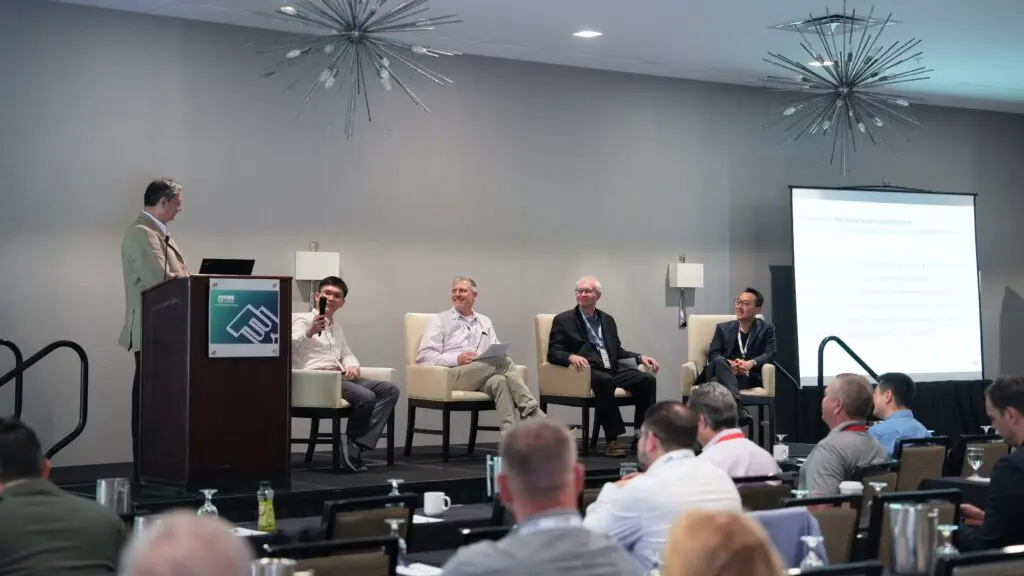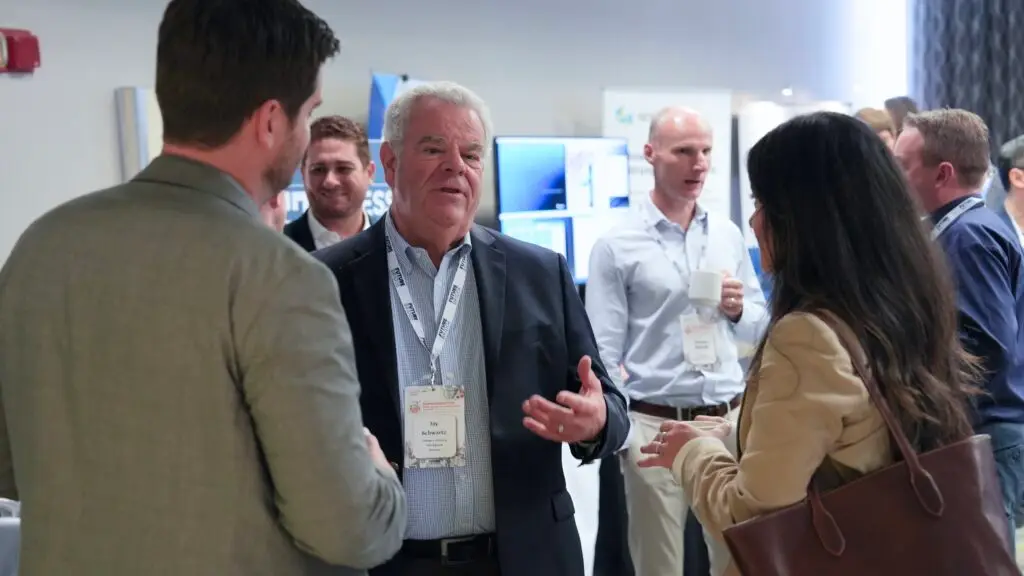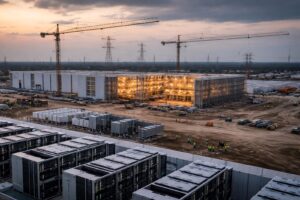The 3rd Semiconductor Fab Design & Construction Summit – East Coast Edition was held in Albany, New York, on June 23–24, 2025. It brought together leaders from the field and boardroom, just as fab construction is picking up pace across the U.S.. But the conversations stayed grounded in what’s slowing delivery: workforce shortages, disconnected data, and utility strain. What follows is a full breakdown of the sessions and sponsors that defined the two-day event.
Sessions at the 3rd Semiconductor Fab Design & Construction Summit – East Coast Edition
The sessions at this 3rd Semiconductor Fab Design & Construction Summit weren’t about polished slides or surface-level updates. Speakers focused on real jobsite and delivery experience. The sessions focused on practical takeaways—what’s working on current fab sites, where teams keep hitting the same roadblocks, and what needs to shift to stay on schedule. Here’s a session-by-session recap, straight from the conversations in the room:
Developing and Retaining Skilled Talent in the Industry
Speaker: Michelle Williams-Vaden, Executive Director, SEMI Foundation
The speaker listed issues holding back talent growth in the industry. She started with the gap between talent and fab readiness. Moreover, she called for better alignment between schools and industry. She pointed to a national credentialing system as one way to reduce confusion around hiring. Childcare, she said, also plays a big role in keeping talent in the workforce—it needs to be affordable and reliable. And without more public visibility, the industry just won’t pull in the numbers it needs to grow.
Digital Transformation: Beyond the Buzzwords
Speaker: Stephen March, Semiconductor Leader, Industrial Automation, Schneider Electric
The speaker focused on how rising demand is driving pressure to scale both new and existing facilities. That pressure, he said, comes with added expectations—efficiency, resiliency, and sustainability. He avoided broad definitions and instead explained what digital transformation looks like in action. He shared examples such as integrated FMCS and predictive energy management. These tools, he noted, delivered ROI in as little as six months. Moreover, he stayed focused on tools already in use and how they’re helping fabs move faster and stay stable as they scale.
Fireside Chat
Speaker: Robert Cunningham, Senior MEP Project Manager, Suffolk
The speaker described recent fab projects and broke down the field issues that slowed them. He focused on MEP coordination and how missed sequencing between trades caused delays and rework. He also emphasized the need for early planning, especially on fast-track builds. Labor availability came up repeatedly, along with how staffing continuity helps with smoother execution. Design intent, he said, often misses field reality. Closing that gap requires better communication across teams. Additionally, the discussion at the 3rd Semiconductor Fab Design & Construction Summit stayed grounded in recent project lessons, with a focus on what slows jobs down and what keeps them moving.
Industrial BIM: Data-Centric Design & Construct for Fabs
Speaker: Greg Elliott, Sr. Director Engineering, Advanced Technologies & Life Sciences, FLUOR Corp; Jay Schwartz, Vice President of Strategy, Hexagon
The speakers laid out how data-centric design works in fab construction. Furthermore, they showed how Hexagon tools connect models, documents, and lists in one platform. That unified system, they said, allows for scalable execution and supports strategies like copy smart, digital twins, tool install, and more. Instead of managing separate data sources, teams work from one system that updates in real time. The approach also helps with traceability and future expansion. So, the focus remained on integrated delivery—from base build through operations.
Panel Discussion: Ideas on How to Improve Project Success
Speaker: Steve Robertson, PMP – Senior Manager Projects (Construction), Wolfspeed; Robert Cunningham, Senior MEP Project Manager, Suffolk
The speakers shared lessons on improving outcomes in semiconductor projects. They said early coordination—especially matching design to field sequencing—makes or breaks fab delivery. In addition, gaps between scopes, they noted, often lead to expensive change orders and rework. Labor came up again, this time tied to how few workers have hands-on experience with tool install or fab-specific systems. Flexibility in execution was another theme. Things will go off script. What counts is how quickly teams react, whether the plan gave them room to adjust, and how well they stay in sync when it does.
Megatrends Shaping Semiconductor Capex Construction
Speaker: Patrick Fedewa, Associate, McKinsey & Company; Dan Peacock, Engagement Manager, McKinsey & Company
The speakers examined how market forces are reshaping semiconductor capex and construction. They began with the effects of tariffs and rapid market growth, then moved into labor shortages and how those challenges are delaying builds. Furthermore, they mapped out where fabs are currently being developed in the U.S. and flagged new announcements. Speakers gave examples of how the engineering talent gap is blocking progress on current fab builds. They shared a few strategies companies are testing to close those gaps, but said most aren’t keeping pace with how fast project demands are rising.
NFPA 70B-Compliant Intelligent Switchgear
Speaker: Chris Allison, President of Explorer Systems and Industry, LLC; Ken Viradia, Industrial Business Development Manager, Siemens Smart Infrastructure
They broke down the latest switchgear tech—systems that can be monitored remotely, catch problems early, and flag maintenance needs before something breaks. These setups don’t just check boxes for NFPA 70B compliance; they help fabs stay ahead of outages instead of scrambling after one hits. They also talked through how digital switchgear turns electrical systems into strategic infrastructure, rather than passive utilities. So, the session stayed focused on fab-specific use cases, where continuous operation and reliability directly affect output, tool performance, and overall plant stability.
Panel Discussion: Aligning Design, Installation & Workforce
Speaker: William Jordan, Mechanical Engineer, NY CREATES; Nick Maryanopolis, Senior Project Manager, Arcadis
The speakers at the 3rd Semiconductor Fab Design & Construction Summit tackled how poor alignment between design and field teams slows fab builds. They pointed to real-world mismatches, like when drawings don’t match site conditions or labor plans overestimate field skill levels. The panel pushed for tighter feedback between design, procurement, and installation teams. They also said early decisions often skip field input, which shows up later as delays or rework. They additionally raised the need for cross-industry training to close workforce gaps. The speakers agreed that without better handoffs between phases, teams waste time translating plans into action instead of building.
Water Stewardship in Advanced Manufacturing Plants
Speaker: Kelly Osborne, AZ Ocotillo Site Infrastructure Engineer, Intel
The speaker laid out how fabs are planning for water reuse from the earliest stages. She emphasized upfront alignment on stewardship goals between site teams, suppliers, and municipalities. Additionally, she explained how reclaim strategies and reuse systems must be designed in, not added later. She also talked through sourcing strategies and business continuity planning for drought and disruption. Technology came up as well—monitoring tools and reuse infrastructure must work together. So, the message was clear: water planning isn’t optional anymore—it’s a core part of fab design.
Power Quality Protection Strategies for Semiconductor Facilities
Speaker: Gary Aw, Global Market Development, Semiconductor Power Protection Products, ABB
The speaker addressed how momentary voltage sags can disrupt semiconductor processes mid-cycle. He explained how these events damage tools, lower yields, and interrupt cleanroom operations. Moreover, recovery times, he said, can be long and expensive. He presented ABB’s approach to power protection—from machine-level systems to plant-wide solutions. The session focused on preventing the most damaging events through innovative electrical infrastructure. Hence, the goal isn’t just protection, he noted, but ensuring consistent performance across all operations in high-sensitivity environments like fabs.

Panel Discussion: Driving Sustainable Electrical Facility Design in Semiconductor Manufacturing
Speaker: Dr. Harsh Karandikar, VP Product Line Manager, ABB; Steven Gibeault, Mechanical Building Engineer – ENG IV, NY Creates; Zhi Rui Mo, Wafer Fab Manager, Sensitron Semiconductor; Dr. CJ Au, Director, Sensitron Semiconductor; Steve Robertson, PMP – Senior Manager, Projects (Construction), Wolfspeed
The speakers at the 3rd Semiconductor Fab Design & Construction Summit explored how fabs can scale while cutting emissions and energy use. They discussed electrified process systems and digital energy tools that optimize power flows in real time. Furthermore, several pointed to how sustainability must be embedded early in design, not added as compliance. Others focused on resilience: systems must work under pressure and still meet environmental targets. They made the case that sustainability isn’t just responsibility—it’s a performance driver. Moreover, across roles, they showed how facilities are shifting from energy consumers to energy-managed systems.
Panel Discussion: Building Resilience in Construction Supply Chains
Speaker: Steven Gibeault, Mechanical Building Engineer – ENG IV, NY Creates; Joe Barber, Vice President, New Business, SourceBlue LLC
The speakers examined how fragile supply chains are slowing fab construction across the board. Teams are facing a new kind of construction pressure: key materials are arriving late, supplier schedules keep shifting, and lead times change with little warning. Contractors are getting hit from both sides. On one hand, equipment is showing up late or not at all. On the other hand, the crews needed to adjust on the fly aren’t always there. That’s pushing teams to order earlier than usual and to keep second sourcing options open. But even that’s not always enough. The panel urged teams to stop reacting and start designing for change, building flexibility into both the plan and the schedule from the start.
Brainstorming Session: The Future of Semiconductor Sustainability
This session dug into the core sustainability hurdles fabs are up against right now. Speakers discussed advanced water recycling systems to address scarcity and how zero-waste goals are reshaping production processes. Carbon reduction strategies were laid out across plant operations—from power to packaging. Biodegradable packaging was raised as an area for immediate innovation. Finally, they explored the need for certifications that prove sustainability performance globally. So, each point was tied to a broader shift: sustainability is no longer a side project—it’s central to semiconductor competitiveness going forward.
Who Were the Sponsors for the 3rd Semiconductor Fab Design & Construction Summit – East Coast Edition?
Sponsors played a direct role in shaping the discussions. Through live demos, technical input, and jobsite examples, they brought real-world context to key issues like sustainability, infrastructure, and execution challenges. What follows is a breakdown of how each sponsor added strategic and operational value throughout the event:
Schneider Electric – Gold Sponsor
Schneider Electric provides the automation and power systems that fabs rely on to run critical operations. In chip plants, their platforms handle electrification, digital control, and facility integration, helping teams lower emissions and manage energy use under real production pressure.
At the 3rd Semiconductor Fab Design & Construction Summit, Schneider showed how predictive systems like FMCS can drive measurable returns in fab environments. Moreover, their session offered practical examples of digital tools that reduced downtime, improved energy efficiency, and helped attendees rethink automation as a value driver, not a future investment.
ABB – Gold Sponsor
ABB Electrification works across over 100 countries to support safe and reliable power systems for industrial sites. In the fab world, they help minimize downtime with intelligent switchgear, multi-layered protection, and predictive infrastructure that’s built to keep operations steady.
At the summit, ABB focused on power quality protection strategies. Additionally, their session highlighted how voltage sags and interruptions threaten yield, and how layered protection—from machine to plant level—can mitigate risk, cut losses, and improve uptime across fab environments.
FLUOR | Hexagon – Silver Sponsor
FLUOR delivers EPCM services for advanced semiconductor facilities, supported by Hexagon’s digital tools for project execution. Together, they enable integrated cleanroom builds, using unified data systems that streamline design, tool install, digital twins, and scalable fab strategies across lifecycles.
At the 3rd Semiconductor Fab Design & Construction Summit, they jointly explored how Industrial BIM enables end-to-end fab design using a unified digital thread. Furthermore, their session showed how real-time data coordination accelerates install phases, reduces errors, and turns BIM from visualization into a performance engine.

McKinsey & Company – Silver Sponsor
McKinsey & Company is a global consulting firm that also works across the semiconductor value chain—from design and assembly to test. Their support ranges from strategy and operations to organization and digital transformation. McKinsey works with semiconductor companies on everything from supply chain snags to sustainability planning.
At the summit, they focused on what’s slowing fab projects in the U.S.—policy uncertainty, labor shortages, and capital constraints—and offered strategies for keeping builds on track. Their session also focused on what those shifts mean for project timelines and how companies can adjust early instead of reacting late.
Siemens – Bronze Sponsor
Siemens supports the core infrastructure inside semiconductor fabs—from automation and HVAC to grid control and fire safety. Their systems are built to manage complex loads, keep utilities stable, and help facilities operate without costly disruptions.
At the summit, Siemens presented a session on NFPA 70B-compliant switchgear, showing how live monitoring tools reduce outages and strengthen overall reliability. Their perspective pushed attendees to view power systems not just as support utilities, but as active drivers of fab performance.
Roxtec – Exhibiting Partner
Roxtec provides certified sealing systems used across semiconductor facilities to block fire, gas, and water. Their solutions—covering EMC, grounding, and hazardous-area protection—make engineering easier, support future capacity needs, and keep cables and pipes secure using multidiameter sealing modules.
At the 3rd Semiconductor Fab Design & Construction Summit, Roxtec’s exhibit highlighted how smart sealing improves utility layout, future expansion, and lifecycle reliability. Furthermore, their systems were especially relevant for attendees designing for adaptability.
Camfil – Exhibition Partner
Camfil designs air filtration and pollution control systems vital to semiconductor production. With 30 manufacturing sites and six R&D units, they focus on sustainability, lifecycle impact, and clean air innovation, enhancing health, energy efficiency, and equipment performance across global operations.
At the summit, Camfil showcased filtration systems essential for maintaining yield and controlling airborne risk. Their presence also reinforced the role of clean air as both a quality and a sustainability driver.
MayAir – Exhibition Partner
MayAir offers advanced cleanroom solutions including FFUs, HEPA/ULPA filters, and HVAC systems. With over 20 years in the industry, they manufacture modular and portable cleanrooms for semiconductor, biotech, and healthcare sectors, ensuring controlled, contamination-free environments for cost-effective production.
As an exhibitor, MayAir demonstrated how cleanroom airflow can be optimized for efficiency and performance. Additionally, attendees engaged with their solutions as part of broader conversations around cleanroom design and scalability.
SourceBlue – Panelist Sponsor
SourceBlue specializes in procurement for large-scale construction, supporting semiconductor projects with early planning and long-lead equipment sourcing. Their team coordinates with stakeholders to streamline procurement and reduce delays, driving efficiency, cost control, and reliability from project start to final delivery..
Their panel at the 3rd Semiconductor Fab Design & Construction Summit on supply chain resilience outlined how transparent planning and vendor coordination protect builds from disruption. Moreover, their insights helped attendees translate procurement into a proactive tool for delivery assurance.
Piller – Exhibition Partner
Piller Power Systems manufactures UPS and Integrated Power Conditioning equipment to safeguard semiconductor production from disruptions. Their infrastructure ensures power quality, protects sensitive tools, and reduces downtime, enabling consistent operations and reliable schedules in high-load, precision manufacturing environments.
At the summit, Piller presented power backup strategies that reduce downtime and protect yield. Their solutions also gave attendees practical options for embedding power resilience in system design.
Arcadis – Panelist Sponsor
Arcadis delivers sustainable design and engineering solutions across global infrastructure, water, energy, and urban development sectors. With 36,000 specialists in 30+ countries, they address climate, urbanization, and digital challenges—empowering clients to build long-lasting, socially and environmentally responsible facilities.
During their panel discussion at the 3rd Semiconductor Fab Design & Construction Summit, Arcadis emphasized how integrated teams can align design, installation, and workforce strategy. Furthermore, their input reinforced that fab construction isn’t just about technical execution—it’s about long-term systems thinking.
To Sum Up
The 3rd Semiconductor Fab Design & Construction Summit – East Coast Edition wasn’t just about technologies—it was about timing, execution, and strategic clarity. Attendees left with sharper questions, new collaborators, and grounded solutions for building fabs that last. If staying ahead of industry shifts is part of your mandate, events like these are the place to be. Attend the next Future Bridge sustainability summit and stay a cycle ahead—before your competitors do.



